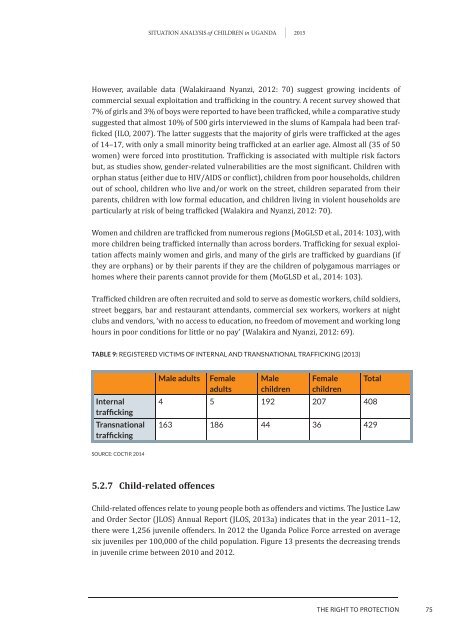Situation analySiS
1TNu802
1TNu802
You also want an ePaper? Increase the reach of your titles
YUMPU automatically turns print PDFs into web optimized ePapers that Google loves.
<strong>Situation</strong> <strong>analySiS</strong> of Children in uganda 2015However, available data (Walakiraand Nyanzi, 2012: 70) suggest growing incidents ofcommercial sexual exploitation and trafficking in the country. A recent survey showed that7% of girls and 3% of boys were reported to have been trafficked, while a comparative studysuggested that almost 10% of 500 girls interviewed in the slums of Kampala had been trafficked(ILo, 2007). The latter suggests that the majority of girls were trafficked at the agesof 14–17, with only a small minority being trafficked at an earlier age. Almost all (35 of 50women) were forced into prostitution. Trafficking is associated with multiple risk factorsbut, as studies show, gender-related vulnerabilities are the most significant. Children withorphan status (either due to HIV/AIDS or conflict), children from poor households, childrenout of school, children who live and/or work on the street, children separated from theirparents, children with low formal education, and children living in violent households areparticularly at risk of being trafficked (Walakira and Nyanzi, 2012: 70).Women and children are trafficked from numerous regions (MoGLSD et al., 2014: 103), withmore children being trafficked internally than across borders. Trafficking for sexual exploitationaffects mainly women and girls, and many of the girls are trafficked by guardians (ifthey are orphans) or by their parents if they are the children of polygamous marriages orhomes where their parents cannot provide for them (MoGLSD et al., 2014: 103).Trafficked children are often recruited and sold to serve as domestic workers, child soldiers,street beggars, bar and restaurant attendants, commercial sex workers, workers at nightclubs and vendors, ‘with no access to education, no freedom of movement and working longhours in poor conditions for little or no pay’ (Walakira and Nyanzi, 2012: 69).TABLE 9: reGistered victims of internAl And trAnsnAtionAl trAfficKinG (2013)InternaltraffickingTransnationaltraffickingMale adultsFemaleadultsMalechildrenFemalechildrenTotal4 5 192 207 408163 186 44 36 429source: coctip, 20145.2.7 Child-related offencesChild-related offences relate to young people both as offenders and victims. The Justice Lawand Order Sector (JLOS) Annual Report (JLOS, 2013a) indicates that in the year 2011–12,there were 1,256 juvenile offenders. In 2012 the Uganda Police Force arrested on averagesix juveniles per 100,000 of the child population. Figure 13 presents the decreasing trendsin juvenile crime between 2010 and 2012.thE rIGht to ProtECtIoN75




